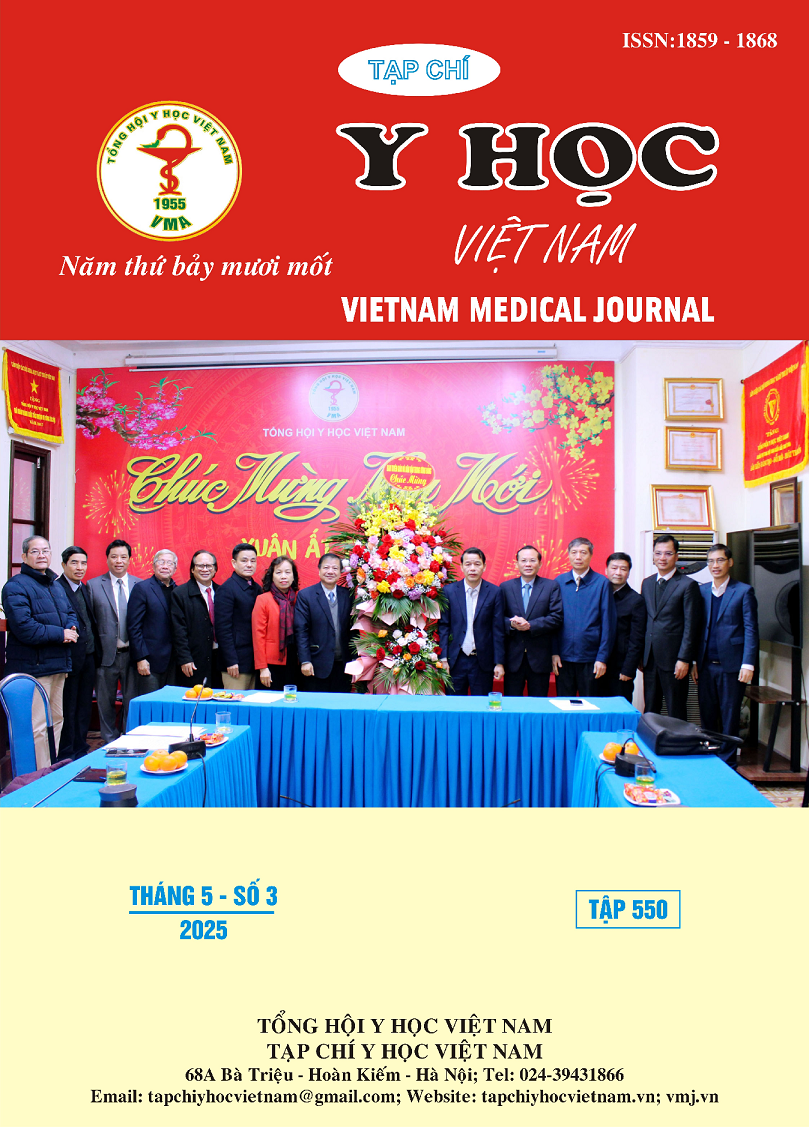IMMUNOHISTOCHEMICAL EXPRESSION OF PREDICTIVE BIOMARKERS ACCORDING TO GENE EXPRESSION SUBGROUPS IN ORAL SQUAMOUS CELL CARCINOMA PATIENTS
Main Article Content
Abstract
Introduction: Oral squamous cell carcinoma (OSCC) is a common head and neck cancer with high rates of metastasis and recurrence, necessitating the identification of novel prognostic biomarkers. Our previous study utilized machine learning models based on mRNA sequencing data and clinical-histopathological features to classify OSCC into two subgroups with distinct molecular and clinical characteristics. It proposed 12 differentially expressed genes between these groups as potential biomarkers. Objective: The current study aimed to evaluate the protein expression of these markers using immunohistochemistry (IHC) in an independent cohort of OSCC patients and determine the association with subgroups predicted by SVM and XGBoost models, combined with preliminary survival analysis. Method: A retrospective study was performed on 50 untreated primary OSCC tissue samples from Vietnamese patients. Results showed that 10 out of 12 markers exhibited protein expression. Results: When subgrouping using the SVM model, four markers (SLAIN2, ADNP, SLK, MARCKS) showed statistically significant differences in protein expression between the two predicted subgroups (p<0.05), consistent with gene expression trends: Subgroup 1 showed increased expression of SLAIN2, ADNP, SLK; Subgroup 2 showed increased expression of MARCKS. With the XGBoost model, only ADNP showed a significant difference. Survival analysis on the limited sample size did not reveal significant differences between the groups. Conclusion: In conclusion, the study confirmed via IHC the differential protein-level expression of SLAIN2, ADNP, SLK, and MARCKS between the SVM-predicted OSCC subgroups, indicating their potential as biomarkers reflecting the molecular subgroups of OSCC. Further studies are needed to validate these markers' prognostic and functional roles.
Article Details
Keywords
Machine learning, Immunohistochemistry, Oral squamous cell carcinoma, OSCC
References
2. Duong HT, Huynh NC-N, Nguyen CT-K, et al. Identify characteristics of Vietnamese oral squamous cell carcinoma patients by machine learning on transcriptome and clinical-histopathological analysis. Journal of Dental Sciences. 2024/12/01/ 2024;19:S81-S90. doi: https://doi.org/10.1016/j.jds.2024.08.013
3. Kosti I, Jain N, Aran D, Butte AJ, Sirota M. Cross-tissue Analysis of Gene and Protein Expression in Normal and Cancer Tissues. Scientific reports. May 4 2016;6:24799. doi:10. 1038/ srep24799
4. Zhu S, Xu Z, Zeng Y, et al. ADNP Upregulation Promotes Bladder Cancer Cell Proliferation via the AKT Pathway. Front Oncol. 2020;10:491129. doi:10.3389/fonc.2020.491129
5. Wang K, Hong RL, Lu JB, Wang DL. Ste20-like kinase is upregulated in glioma and induces glioma invasion. Neoplasma. 2018;65(2):185-191. doi:10.4149/neo_2018_170318N193
6. Manai M, I EL-D, Finetti P, et al. MARCKS as a Potential Therapeutic Target in Inflammatory Breast Cancer. Cells. Sep 19 2022;11(18) doi:10.3390/cells11182926
7. Chen CH, Chiu CL, Adler KB, Wu R. A novel predictor of cancer malignancy: up-regulation of myristoylated alanine-rich C kinase substrate phosphorylation in lung cancer. Am J Respir Crit Care Med. Apr 15 2014;189(8):1002-4. doi:10.1164/rccm.201401-0053LE
8. Chen CH, Fong LWR, Yu E, Wu R, Trott JF, Weiss RH. Upregulation of MARCKS in kidney cancer and its potential as a therapeutic target. Oncogene. Jun 22 2017;36(25):3588-3598. doi:10.1038/onc.2016.510
9. Chen CH, Cheng CT, Yuan Y, et al. Elevated MARCKS phosphorylation contributes to unresponsiveness of breast cancer to paclitaxel treatment. Oncotarget. Jun 20 2015;6(17):15194-208. doi:10.18632/oncotarget.3827


